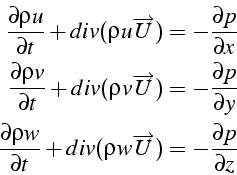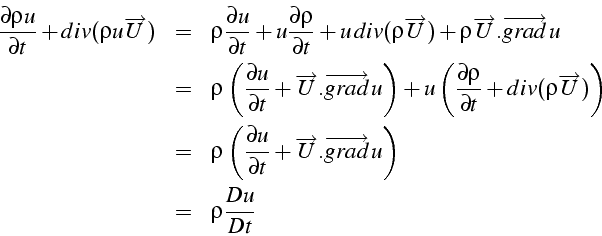suivant: 1.6 Equation de bilan monter: 1. Description d'un gaz précédent: 1.4 Equation de bilan Table des matières
La loi fondamentale de la dynamique: la variation de la quantité
de mouvement dans l'élément ![]() est égale à la somme des efforts
appliqués
est égale à la somme des efforts
appliqués

Les efforts extérieurs appliqués sur l'élément sont:
Avec ces approximations, la somme des forces de pression s'écrit pour l'élément de la figure 1.1:

En effectuant un développement limité à l'ordre 1, on obtient:

ce qui conduit à l'équation de bilan de quantité de mouvement:

soit sous forme vectorielle (forme conservative)

qui correspond aux 3 équations scalaires en coordonnées cartésiennes:

On peut écrire une forme conservative complète en notant
![]() le tenseur identité
le tenseur identité
![$\left[\begin{array}{ccc}
1 & 0 & 0\\
0 & 1 & 0\\
0 & 0 & 1\end{array}\right]$](img209.png) :
:

La forme non conservative (ou convective) s'obtient en développant le terme en divergence et en utilisant l'équation de bilan de masse:


De cette équation, on peut en déduire une équation de bilan sur l'énergie
cinétique en effectuant le produit scalaire avec le vecteur vitesse
![]()
